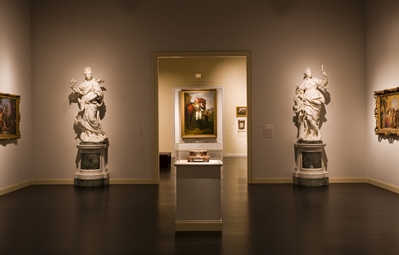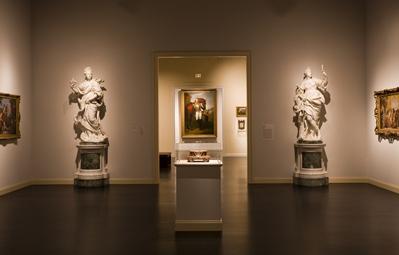On view now in our European galleries are two life-size allegorical figure statues, Wealth and Prudence, by the late Florentine Baroque master, Giovanni Baratta (1640–1747)—just acquired through the largess of The Ahmanson Foundation. The rediscovery of these sculptures has been recognized as a major contribution to the study of early eighteenth-century Florentine art.

Giovanni Baratta, Wealth (left) and Prudence (right), 1709, gift of the Ahmanson Foundation
Originally part of one of Baratta's most illustrious commissions, the worksare noted for their refined elegance. The sculptures were commissioned by Niccolò Maria Giugni (1672-1717) for the gallery in his Palazzo on the Via degli Alfani in Florence. Facing one another at either end of the gallery, they were part of an elaborate iconographic scheme intended to glorify the Medici family and celebrate the Giugni family’s allegiance to the Medici. The choice of Wealth and Prudence was particularly appropriate to illustrate the joint virtues of the families, as some members of the Giugni family had advised the Medici in various aspects of their governance. The two allegories closely match the iconology of the subjects: Wealth is a woman bedecked with jewels and holding a crown in one hand, a scepter in the other (the scepter may either have disappeared or never have been intended by the sculptor); Prudence is identified by the mirror she's holding as well as an arrow and eel, all of which appear distinctly in Baratta's sculpture. In addition to their size, the extraordinary quality of carving in the sculptures is noted. Of particular beauty are the hands whose fingers delicately press the fabrics, and folds that are thinly and sharply executed in a way that carries into the eighteenth-century tradition of Bernini, in whose studio Baratta's uncle had worked. The sculptures were executed shortly before 1709, at the height of Baratta's fame. Shortly after, with well-established international recognition, he received commissions globally, including those from the Duke of Marlborough ("Princely Glory", Cambridge, Fitzwilliam Museum), the King of Denmark (Peace, Fedensborg Castle), and the Royal House of Savoy in Turin (Decoration of the Church of St. Hubert in the Venaria Reale). As the first marble examples of Baroque Florentine sculptures to enter the collection, Wealth and Prudence are an important addition to LACMA’s extensive grouping of late seventeenth- and early eighteenth-century Florentine sculpture. The Baratta works join a bronze by Antonio Montauti, as well as a gilded terra-cotta, a wax relief, and medals by Massimilliano Soldani-Benzi, amongst other notable works currently on view in the museum’s European galleries. J. Patrice Marandel, the Robert H. Ahmanson Chief Curator of European Art



